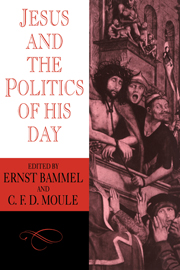Book contents
- Frontmatter
- Contents
- Abbreviations
- Foreword
- The Zealots and Jesus
- The revolution theory from Reimarus to Brandon
- The date and character of Mark
- Some observations on Tendenzkritik
- Argumentum e silentio
- The Poor and the Zealots
- The opposition between Jesus and Judaism
- Judaeo-Christianity and the Jewish establishment, A.D. 33–66
- A.D. 70 in Christian reflection
- The trial of Jesus in the Acta Pilati
- Christ as brigand in ancient anti-Christian polemic
- Jesus as a political agent in a version of the Josippon
- The Feeding of the Multitude
- The coin of ‘Render unto Caesar …’ (A note on some aspects of Mark 12: 13–17; Matt. 22: 15–22; Luke 20:20–26)
- Render to Caesar
- The Temple tax
- ‘Not peace but a sword’: Matt. 10:34ff; Luke 12: 51ff
- The decision of the Supreme Court to put Jesus to death (John 11:47–57) in its context: tradition and redaction in the Gospel of John
- The ‘triumphal’ entry
- The two swords (Luke 22: 35–38)
- The titulus
- Romans 13
- Biblical criticism criticised: with reference to the Markan report of Jesus's examination before the Sanhedrin
- The political charge against Jesus (Luke 23: 2)
- The trial before Pilate
- ‘His witness is true’: A test of the Johannine claim
- Index of Authors
- Index of References
The Zealots and Jesus
Published online by Cambridge University Press: 19 January 2010
- Frontmatter
- Contents
- Abbreviations
- Foreword
- The Zealots and Jesus
- The revolution theory from Reimarus to Brandon
- The date and character of Mark
- Some observations on Tendenzkritik
- Argumentum e silentio
- The Poor and the Zealots
- The opposition between Jesus and Judaism
- Judaeo-Christianity and the Jewish establishment, A.D. 33–66
- A.D. 70 in Christian reflection
- The trial of Jesus in the Acta Pilati
- Christ as brigand in ancient anti-Christian polemic
- Jesus as a political agent in a version of the Josippon
- The Feeding of the Multitude
- The coin of ‘Render unto Caesar …’ (A note on some aspects of Mark 12: 13–17; Matt. 22: 15–22; Luke 20:20–26)
- Render to Caesar
- The Temple tax
- ‘Not peace but a sword’: Matt. 10:34ff; Luke 12: 51ff
- The decision of the Supreme Court to put Jesus to death (John 11:47–57) in its context: tradition and redaction in the Gospel of John
- The ‘triumphal’ entry
- The two swords (Luke 22: 35–38)
- The titulus
- Romans 13
- Biblical criticism criticised: with reference to the Markan report of Jesus's examination before the Sanhedrin
- The political charge against Jesus (Luke 23: 2)
- The trial before Pilate
- ‘His witness is true’: A test of the Johannine claim
- Index of Authors
- Index of References
Summary
The theory that Jesus was mixed up with the movement or party of armed resistance to Rome commonly called the Zealots has never lacked proponents (cp. the following essay), but latterly it has achieved new force and publicity through a combination of factors: the excavation of the Zealot stronghold at Masada by Yigael Yadin, and the glorification of Zealot heroism;1 current concern as to the authentic Christian role in resistance to oppressive regimes; and the work of the late S. G. F. Brandon. In his Jesus and the Zealots (Manchester, 1967), which built on his earlier book, The Fall of Jerusalem and the Christian Church (London, 1951), he claimed not that Jesus actually was a Zealot, a member of the party (if there was such a party in his time), but that Jesus and his disciples sympathised with the ideals and aims of the Zealot movement, and so did the earliest Christians.
Brandon's work was taken up as substantiating his own hunch by Colin Morris, formerly a Methodist minister in Zambia and adviser to President Kaunda, in a popular paper-back, Unyoung, Uncoloured, Unpoor (London, 1969). To quote the summary on the back,
its theme is simply that the world is ruled by the Unyoung, Uncoloured and Unpoor and that only violent revolution will overthrow them in order to give the majority of the world's population their due place in the sun. Claiming that the Christian has both the right and the responsibility to take part in this struggle, Morris offers a re-interpretation of Jesus which challenges the traditional view that he was innocent of sedition against the Roman authorities.
- Type
- Chapter
- Information
- Jesus and the Politics of his Day , pp. 1 - 10Publisher: Cambridge University PressPrint publication year: 1984
- 3
- Cited by



